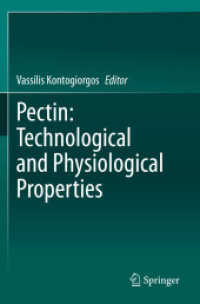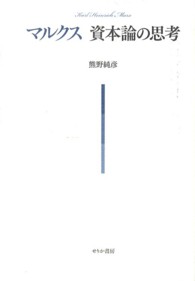- ホーム
- > 洋書
- > ドイツ書
- > Mathematics, Sciences & Technology
- > Earth Science
- > geology
Full Description
This is the second of two volumes devoted to earthquakes and multi-hazards around the Pacific Rim. The circum-Pacific seismic belt is home to roughly 80% of the world's largest earthquakes, making it the ideal location for investigating earthquakes and related hazards such as tsunamis and landslides. Following the Introduction, this volume includes 14 papers covering a range of topics related to multi-hazards. The book is divided into five sections: viscoelastic deformation, earthquake source models, earthquake prediction, seismic hazard assessment, and tsunami simulation.Viscoelastic relaxation can play an important role in subduction zone behavior, and this is explored in the first section, with specific examples including the Tohoku-oki earthquake in Eastern Japan. In addition to laboratory rock friction experiments, the second section examines earthquake source models for the 2016 MW 6.6 Aketao earthquake in Eastern Pamir and two earthquakes in Eastern Taiwan, along with strong ground motion studies of the 2008 MW 7.9 Wenchuan, China earthquake. The Load/Unload Response Ratio (LURR), Natural Time (NT), and "nowcasting" are earthquake prediction techniques that are analyzed in the third section, with nowcasting predictions performed for a number of large cities globally. Viscoelastic relaxation can play an important role in subduction zone behavior, assessment are the focus of the fourth section, with specific applications to the Himalayan-Tibetan region and the Xianshuihe Fault Zone in Southwest China. In the last section, a new approach in modeling tsunami height distributions is described.
Rapid advances are being made in our understanding of multi-hazards, as well as the range of tools used to investigate them. This volume provides a representative cross-section of how state-of-the-art knowledge and tools are currently being applied to multi-hazards around the Pacific Rim. The material hereshould be of interest to scientists involved in all areas of multi-hazards, particularly seismic and tsunami hazards. In addition, it offers a valuable resource for students in the geosciences, covering a broad spectrum of topics related to hazard research.
Contents
Earthquakes and Multi-Hazards Around the Pacific Rim, Vol. II: Introduction.- Subduction Mode Selection During Slab and Mantle Transition Zone Interaction: Numerical Modeling.- Characteristics of Viscoelastic Crustal Deformation Following a Megathrust Earthquake: Discrepancy Between the Apparent and Intrinsic Relaxation Time Constants.- Interpretation of Offshore Crustal Movements Following the 2011 Tohoku-Oki Earthquake by the Combined Effect of Afterslip and Viscoelastic Stress Relaxation.- Rupture Characteristics of the 25 November 2016 Aketao Earthquake (Mw6.6) in Eastern Pamir Revealed by GPS and Teleseismic Data.- Source Characteristics of the Northern Longitudinal Valley, Taiwan Derived from Broadband Strong-Motion Simulation.- Fault Structural Control on Earthquake Strong Ground Motions: the 2008 Wenchuan Earthquake as an Example.- Voids and Rock Friction at Subseismic Slip Velocity.- A Dimensional Analysis Method for Improved Load/Unload Response Ratio.- Natural Time, Nowcasting and the Physics of Earthquakes: Estimation of Seismic Risk to Global Megacities.- Natural Time and Nowcasting Earthquakes: Are Large Global Earthquakes Temporally Clustered?.- Optimal Scaling of Aftershock Zones Using Ground Motion Forecasts.- Probabilistic Seismic Hazard Assessment for Himalayan-Tibetan Region from Historical and Instrumental Earthquake Catalogs.- Scenario-Based Seismic Hazard Analysis for the Xianshuihe Fault Zone, Southwest China.- Tsunami Simulation Method Assimilating Ocean Bottom Pressure Data near a Tsunami Source Region.







